Last years race was a bit of an eye-opener so I was careful to learn from it and take a different approach this time around.
The Lake Wanaka Half is the "easy" option of Challenge Wanaka. It's a half-iron distance triathlon on a fairly difficult course and the weather often adds to the suffering with high temperatures and strong winds.
Pre-Race
The swim and the run both gave me big challenges last year. The swim problem was due to cold-water sensitivity causing hyperventilation, which explained the shortness of breath I'd had in my previous open-water swims in warmer waters (the lake was 15°C). The problem in the run was due to bloating combined with a lack of preparation and a poor nutrition plan, which all hit me about 3km into the half-marathon. Finishing that race was one of the proudest moments of my life because of the way I'd overcome the swim and pushed through the hurt on the run. My time was pretty unremarkable but that didn't matter, I was only wanting to stubbornly finish without walking.
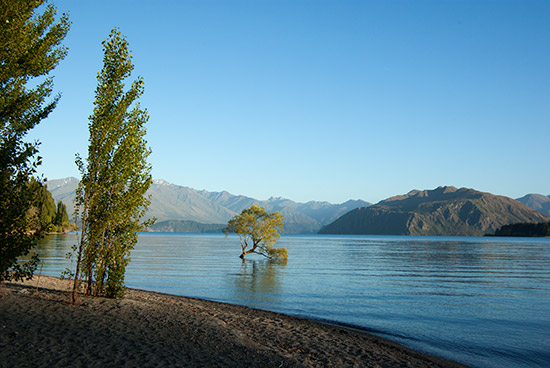 Lake Wanaka Lake Wanaka(Photo: Me; click to enlarge) |
This year I took that experience on board and tried to make sure that neither of those problems would affect me this time around. I'd still had problems in the Rolf Prima race in Ashburton in November so I'd had a bit of a hurried effort to get to the bottom of them.
It turned out that the bloating was caused by swallowing too much air as I drank on the bike, so I replaced my Profile aero bottle with an Xlab one which has a bite-valve. For cold water adaptation I was taking cold showers, which is harder than it sounds.
I took a more relaxed approach and travelled down there a bit earlier this time - largely because I wanted to get plenty of swimming in the lake but also because I wanted to be more relaxed. Last year I'd gone down on the Thursday which meant I was rushed off my feet getting ready for race day and the stress won't have helped.
In addition to getting there early, having done the race last year helped a lot with the preparation as I mostly knew the procedures, rules and course (there were a few small changes). I was able to get things done a lot earlier and avoid the last-minute rush which helped greatly with my state of mind. I was also surer of my preparation, having spent a whole year building up instead of just a few months.
The house we stayed in is very close to the lake so it was easy to wander down for a swim. Most days I just wanted to have a 10-minute dip to acclimatise to the cold water. I found that the cold showers I've been having since November have helped a great deal in conditioning my body to cold water and I found it very easy to get in when the lake was 15°C. My wife found it a bit cold for her liking! I wasn't using the wetsuit for these short sessions and I don't have a lot of natural padding so I did need to be careful as I was coming out slightly hypothermic after these short swims. They went a long way to alleviating my anxiety though and I was confident that I wouldn't suffer any swim problems on race day.
On the Thursday I was scheduled to have a 45-minute swim in the lake but the wind was up and the swell was getting fairly large - I stood up and found the troughs at my hips and the peaks at my shoulders. I spent 10 minutes swimming with and against the swell as practice, then got out again. It was a pity as I'd really wanted to go around the course at least once.
The lake temperature varied more than I expected: it rose to 16°C as of the race briefing on Friday, then fell overnight to 14°C on race day. Given my experiences in the preceding days I chose to wear both my neoprene cap and neoprene socks to prevent heat loss.
The Race Plan
Naturally I had set myself some goals for the race:
- No cold-water problems
- Get the nutrition right, no blowups on the run
- No bloated feeling on the run
- Target bike split 3 hours (was 3:17 last year)
- Target run split 2 hours (was 2:47 last year after the blowup)
- Target finish time 6 hours
- Most importantly, enjoy the day.
During the days leading in to the race I decided to keep the time-based goals as a low priority because I didn't want to feel disappointed if I'd had a smooth race but missed a time target. The overwhelmingly important goals were to avoid the problems of last year.
The weather was forecast to be much nicer than last year, with light winds but a chilly morning. The lake wasn't as high so the run was held on the usual course around the outlet track.
As for the race itself, my plan was to swim easy, bike fairly hard and just hold on for the run. My rehabilitation from the marathon injuries was only at the point where I could run a half marathon, but not push much of a pace for fear of relapse.
Race Day
When I put my tri suit on before heading down to the start I made sure I put sunscreen on. This is a trick I used last year - it'll easily last through the swim and means I don't have to take any time applying some in T1. I assume everyone does this...
Once again I had to ask a volunteer where the timing mat is for checking into the swim start. It was in a better place this year but they'd said it would be clearly marked, which it wasn't. There tend to be a lot of athletes and their supporters milling about so it's not easy to see.
I had a timing plan for getting the wetsuit on and getting into the lake but finding out where the mat is ate a couple of minutes off that. I had left a little fat in the schedule so it didn't matter too much. I got into the lake and had as much warmup as I needed. I find breast stroke works very well in cold water as you don't have to start getting your head under until you're ready for it and you can do so gradually while swimming, then change to freestyle afterwards.
My breathing was very good although the water did feel very cold compared to the past few days. Soon enough we were swimming out to the start line for the agonising wait until we're given the signal to go.
The Swim
Like last year I stayed towards the back at the start because I'm not a fast swimmer. The last thing I want to do is get in everyones way and have them all flying past me. I was surprised at how choppy it can get with all those swimmers but I stayed relaxed in the knowledge it'd get smoother when the field spreads out a bit.
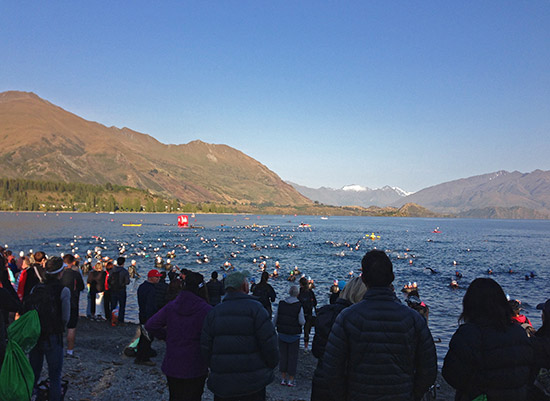 The swim start: white caps of a different sort this year The swim start: white caps of a different sort this year(Photo: My lovely wife; click to enlarge) |
The swim was very pleasant, I got into a nice rhythm and swam relaxed which was exactly what I'd planned. I went a little wide along the first leg because my sighting landmark was slightly off but it didn't bother me and probably didn't add an awful lot of distance. Not like Ashburton where I took a wrong turn. It's such a nice swim in Lake Wanaka with the clear water and the amazing mountain views you get every time you breathe. The clarity of the water helped a lot in seeing where other swimmers were going.
I found the cold water was making my arms feel sore for a while but there was nothing I could do about that except press on. I knew a bit of body heat would reach them eventually and they came right somewhere after the first turn.
The last leg is always a pain on that swim course; due to the timings you end up swimming directly into the sun so sighting is very difficult. For some reason this leg also felt excruciatingly long, maybe because I was less relaxed. I was sighting on Mt Iron most of the time but sometimes just following the other swimmers. I ended up exactly on course as I approached the final buoy which was nice, especially as I didn't see it until I was almost about to hit it.
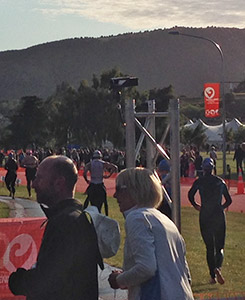 Heading towards T1 (I'm at the centre, in the white top) Heading towards T1 (I'm at the centre, in the white top)(Photo: My lovely wife; click to enlarge) |
I came out of the water in 40:56 (which I didn't know at the time) which I'm very pleased with. I think I was about 43:00 in Ashburton after taking the wrong turn and I'd been happy with that. Last year was about 55:00 due to the cold-water issues and the swell, this time there were no excuses to hide the fact that I'm not a fast swimmer!
I got the top half of the wetsuit off on my way to my T1 bag. After picking up the bag I tried getting my earplugs out while running but it slowed me down as it's quite fiddly and I had to concentrate, so I think next time I'll wait until I'm in the change tent. The tent was packed and it took me a few moments just to find a space.
I haven't mentioned the air temperature yet... the water was officially 14.1°C and the air was something like 5 or 6°C that morning. This combination meant fairly numb fingers in T1 which made it interesting to say the least. I'm not the fastest at transitions even on a good day so my 7:54 time is hardly a surprise. Note this includes a fair bit of running about. It looks like quite a few guys were a bit on the slow side that day so I'm not too disappointed.
The Bike
Getting out on the bike is something I'd been looking forward to as the bike course is very scenic if you have the time to look, especially the first section which heads out-and-back past Glendhu Bay with rolling hills and amazing lake views. Plus I enjoy riding more than I enjoy swimming. My fingers and toes were quite numb to start with; I'd forgotten to pack my arm warmers which was a bit annoying but I hadn't exactly anticipated a need for them in the middle of summer.
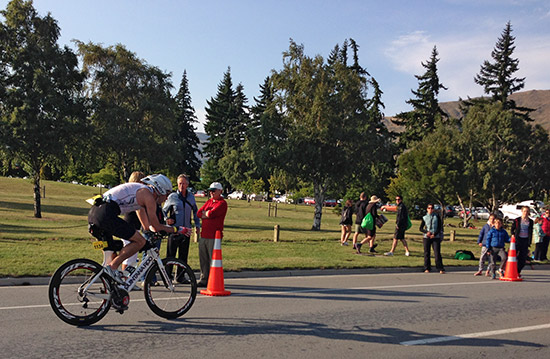 Heading out on the bike Heading out on the bike(Photo: My lovely wife; click to enlarge) |
The first part of the bike had a couple of scary moments as that's where the fast team riders started to come through. I didn't know that teams are started 15 mins after individuals so even a slow swimmer like myself will be ahead of them to start with. I noticed a lot of team riders engaging in dodgy overtaking moves - one guy passed so close to me that I got a fright, then he started cutting in front. I know it's my responsibility to drop back as per the drafting rules but I shouldn't need the brakes to do so! I also saw people 3 and even 4 across as they passed slower riders.
Approaching the first aid station I remembered that picking up a bottle with my left hand would be quite hard - I usually wrangle bottles with my right hand so I'm far more confident with my left hand on the bar. That's something I should have anticipated and I'll have to work on it in training. I dropped the first bottle but managed to get the second.
About 30km into the ride I'd had the feeling restored in my fingers, and it took about another 20km to get it back in my toes. I was still holding a good pace though. The only down side of the first section of the bike is the amount of riders I needed to pass. A good incentive for me to improve my swimming I suppose (I think I said that last year).
Another big plus this year is that I'd taught myself to pee on the bike. It's not something I was willing to do in training due to the cleanup, but I worked it out in my Ashburton race and it saved me several minutes from not having to stop. They key for me is to stop the flow before it starts to drip out of my shorts, so it won't get into my shoes (and won't be so obvious to others). So you need to go a little bit, fairly often as your shorts dry out. But if you drink too much you just have to let it go. Better that than dehydrating!
The rest of the bike course was uneventful. It was nice to have still conditions and the two bridges were a pain - the cycleway on the Albert Town bridge is very bumpy even with the carpet they'd laid over it, and the red bridge near Luggate had some metal plates and rows of bolt heads sticking up so you had to be very careful. Some parts of the road surface, especially on the Hawea Flat, were so rough I thought the bike would disintegrate underneath me. Rough surfaces are very fatiguing to ride on in the TT position, especially for the neck muscles, but I had less of an issue with that this year after some specific strengthening work and a lighter helmet.
The big curving downhill that precedes the red bridge was less scary this year - last year I got a little worried as I felt a small wobble in the bike on the way down the hill, so I'd sat up and gently feathered my rear brake to keep my speed under control. I assumed it was an effect of the wind but it was slightly disturbing. I still remember the guy who passed me as if I was standing still, down on his aerobars. That takes some balls. This year I still sat up (as I did on all of the downhills) but had no wobbles and didn't need to use the brakes.
I felt a lot better on the ride this year - last year I wasn't so well conditioned to the TT position and kept needing to sit up after turning onto Riverbank Rd for the final section. This may also relate to the bloating I had in the run last year (and also in Ashburton), but my new bottle seemed to be working and I felt a lot better.
I came off the bike in an official time of 3:00:03 - close enough to my 3hr target. It did make me wonder why they put the timing mat after the dismount line. I would consider mounting and dismounting to be part of transition. But that's nothing to do with those 3 seconds! Maybe it's unsafe for people to be braking as they cross a timing mat.
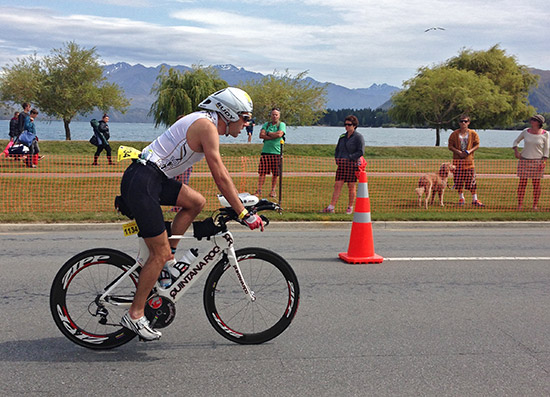 Coming into T2, finally warmed up Coming into T2, finally warmed up(Photo: My lovely wife; click to enlarge) |
T2 went smoothly and at 4:18 was a better performance than T1 compared to others. It felt quite slow as I had to change glasses and take off my bike shorts (I put them on over my tri shorts for extra comfort). I'd bought some new sunglasses for the run the day before the race but I didn't know if they'd be any good on the bike, so I'd worn my normal bike glasses. So that's a good potential time saving.
I grabbed a squirt of sunscreen on the way out of the tent and applied it on-the-hoof. I didn't worry about my legs, opting to just cover my face, arms and shoulders.
The Run
Normally I run way too hard off the bike. I don't suffer from the jelly-legs that others do. I think it's because my legs have been working hard on the bike so a faster run pace just feels natural. I was careful to hold back a little bit this time - last year I shot out at about 4:30/km (according to the official 2km split) which is way too fast for me. This year I was wearing my Garmin watch for the run so I could watch my pace and it was closer to 5:00/km at the start, which was still too fast but I was prepared to stick with it, at least until I was past the spectators. Looking fast is more important than being fast.
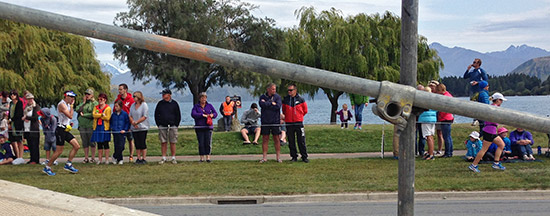 Heading out for a nice scenic run (I'm at the left) Heading out for a nice scenic run (I'm at the left)(Photo: My lovely wife; click to enlarge) |
I would have loved to push a good pace on the run but because I'm still recovering from the injuries sustained in the Christchurch Marathon last year (stress fracture and achilles problems) I needed to keep the pace under control anyway. I kept my pace a bit too fast but it slowly decreased as I worked my way around the course, as I knew it would.
I got to about 8km before I started to feel fatigued but I didn't need to slow down by much. I got a gel in at the next aid station which helped a lot, just in time for Gunn Rd. I took it easy up the hill then got back into a nice rhythm on the way back down.
Once we came off the hill and back onto the lakeside track I could see the start/finish area but I knew it was still a few km away yet so just concentrated on keeping my run nice and smooth. Then when I turned the last corner onto Aardmore St I found the fatigue evaporating. I flew along the road towards the finish chute doing 4:00/km. If only I could have summoned that kind of energy 10km ago!
I crossed the line with a run split of 2:08:38 for a total time of 6:01:48 and I was absolutely stoked. It was quite emotional coming through that last section because the hard work had paid off and I'd overcome the problems from last year.
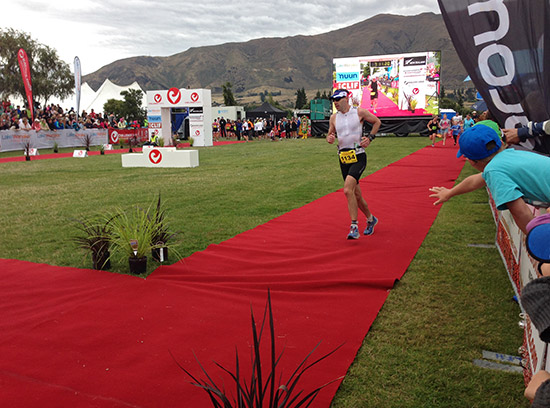 About to finish About to finish(Photo: My lovely wife; click to enlarge) |
The Aftermath
After finishing and chatting with my coach in the recovery tent I picked up my recovery bag with its bottle of Powerade and delicious Em's Power Cookie. Then I went outside and met up with the wife. I decided against riding in our rented 4WD for the trip back. I didn't really like the idea of sitting on the car seat with my pee-soaked tri shorts still on. It's not a long walk back to our house and I was keen to dip my legs in the lake on the way there as an ersatz ice bath. My quads were just about seizing at the time so keeping them moving was a priority.
So, how did I fare against my goals?
- No cold-water problems: SUCCESS
- Get the nutrition right, no blowups on the run: SUCCESS, although I do need to tweak the nutrition
- No bloated feeling on the run: SUCCESS
- Target bike split 3 hours (was 3:17 last year): Close enough. I'm not arguing over 3 seconds.
- Target run split 2 hours (was 2:47 last year): Not far off: I'd neglected to account for the hill (we ran the Plan B course last year) but had also run on the flat at a faster pace than planned.
- Target finish time 6 hours: Close enough.
- Most importantly, enjoy the day: EMPHATIC SUCCESS.
What Next?
Now I have to ask myself the question I've been putting off - what next? I had wanted to train for the full IM distance this year but the marathon injuries put a stop to that. I then re-evaluated and realised that I needed to have a couple of really good 70.3 races before attempting the full distance anyway, just to make sure I have all the issues sorted out. This was that first good one.
Because my running still isn't 100% my thoughts are leaning towards sticking with the shorter distance for another year. That way I can spend this year putting my injuries 100% behind me and get the running up to scratch.
I've been looking at races to do and more 70.3 races during the year would mean travelling overseas which adds massive expense and hassle, so I'm not sure what I'll do. I love this distance and would like to get more practice to make some improvements with my nutrition. Worst case I can just schedule some massive bike-run sessions in training...
Footnote
Challenge Wanaka have announced a change of date for 2015 - the race will be on Feb 22nd next year. Bit of a surprise but I think it's a very good move. I was actually thinking about that in the days leading up to the race because of the lake temperature - I thought another month or two would make the lake warmer and give us some more time to train in the nice summer weather. Great minds I suppose.
They've given their reasons for it and I think they're very good ones, it's clear they've decided in the best interests of both the athletes and the local community. Hopefully it'll mean less traffic on the bike course as it won't be school holidays (it's only the section on SH6 that was busy but it always felt safe). It also gets away from the absurd situation of having the Auckland 70.3 on the same weekend, which many people feel was a deliberate move by WTC to upset Challenge Wanaka.
I've heard a couple of complaints - one from a teacher who would prefer it to be during his holidays, and another from someone wanting to use the race as buildup for the Taupo Ironman. But that would only affect a handful of athletes and they could use the Auckland 70.3 as their buildup race. Or indeed target the full Challenge Wanaka instead...



